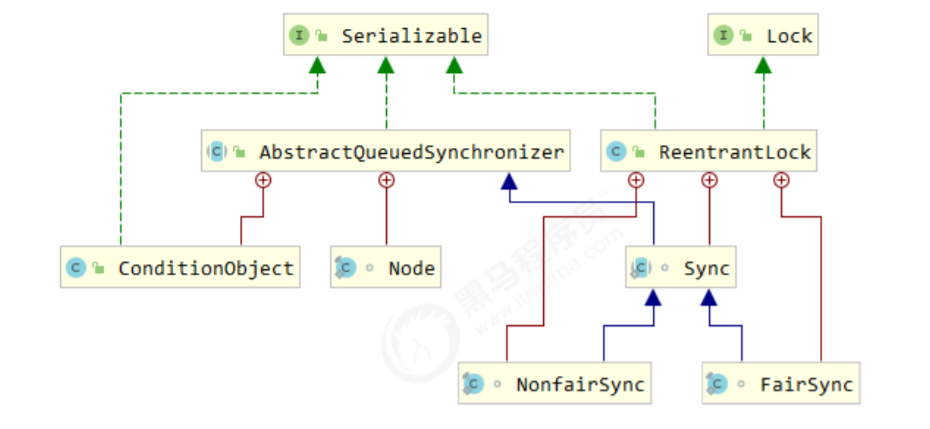1、非公平锁实现原理
加锁解锁流程 先从构造器开始看,默认为非公平锁实现
public ReentrantLock() {sync = new NonfairSync();}
NonfairSync 继承自 AQS
没有竞争时 
第一个竞争出现时 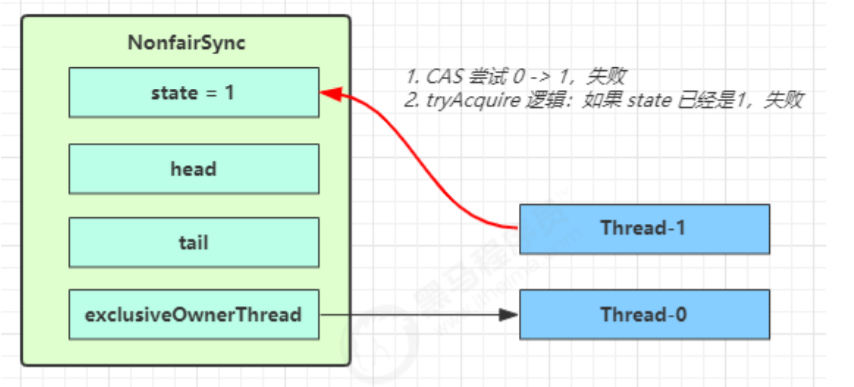
Thread-1 执行了
- CAS 尝试将 state 由 0 改为 1,结果失败
- 进入 tryAcquire 逻辑,这时 state 已经是1,结果仍然失败
- 接下来进入 addWaiter 逻辑,构造 Node 队列
图中黄色三角表示该 Node 的 waitStatus 状态,其中 0 为默认正常状态
Node 的创建是懒惰的
其中第一个 Node 称为 Dummy(哑元)或哨兵,用来占位,并不关联线程
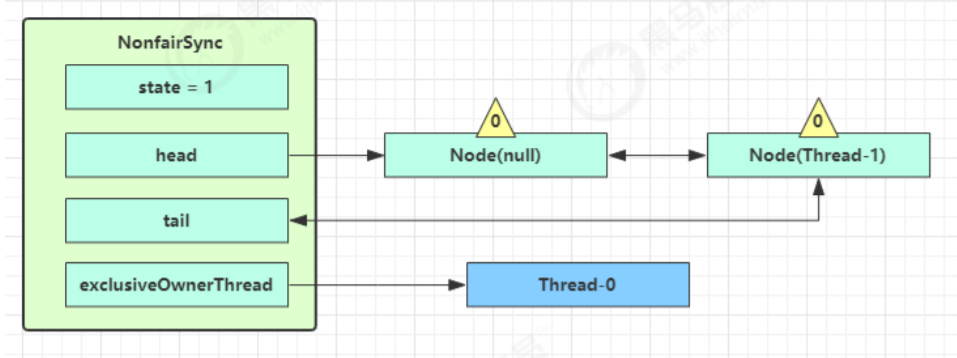
当前线程进入 acquireQueued 逻辑
- acquireQueued 会在一个死循环中不断尝试获得锁,失败后进入 park 阻塞
- 如果自己是紧邻着 head(排第二位),那么再次 tryAcquire 尝试获取锁,当然这时 state 仍为 1,失败
- 进入 shouldParkAfterFailedAcquire 逻辑,将前驱 node,即 head 的 waitStatus 改为 -1,这次返回 false
- shouldParkAfterFailedAcquire 执行完毕回到 acquireQueued ,再次 tryAcquire 尝试获取锁,当然这时 state 仍为 1,失败
- 当再次进入 shouldParkAfterFailedAcquire 时,这时因为其前驱 node 的 waitStatus 已经是 -1,这次返回 true
- 进入 parkAndCheckInterrupt, Thread-1 park(灰色表示)
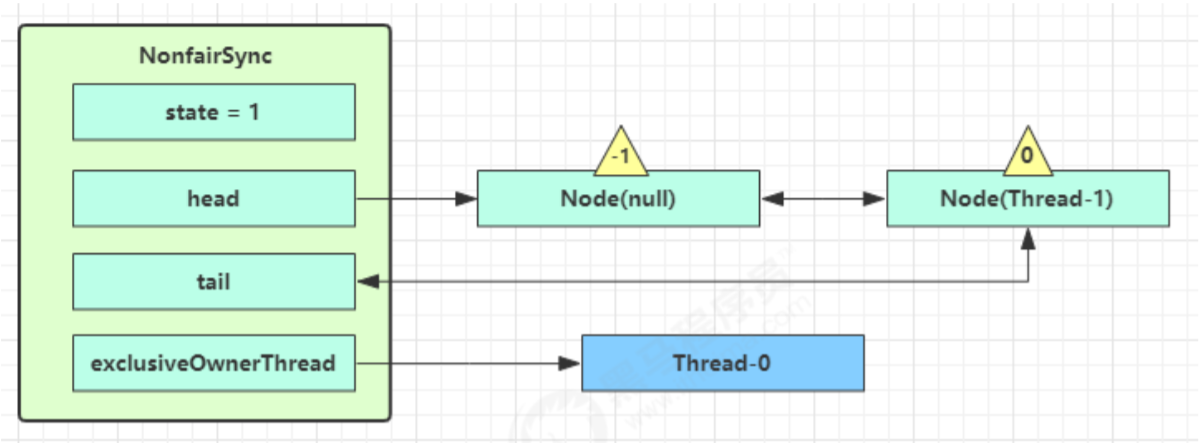
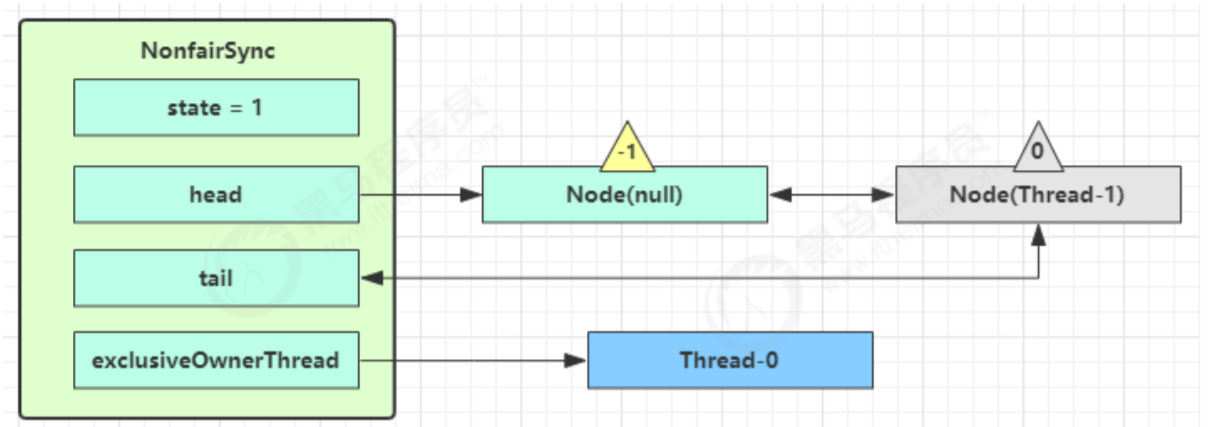

Thread-0 释放锁,进入 tryRelease 流程,如果成功
- 设置 exclusiveOwnerThread 为 null
- state = 0

当前队列不为 null,并且 head 的 waitStatus = -1,进入 unparkSuccessor 流程
找到队列中离 head 最近的一个 Node(没取消的),unpark 恢复其运行,本例中即为 Thread-1
回到 Thread-1 的 acquireQueued 流程 
如果加锁成功(没有竞争),会设置
- exclusiveOwnerThread 为 Thread-1,state = 1
- head 指向刚刚 Thread-1 所在的 Node,该 Node 清空 Thread
原本的 head 因为从链表断开,而可被垃圾回收
如果这时候有其它线程来竞争(非公平的体现),例如这时有 Thread-4 来了

如果不巧又被 Thread-4 占了先Thread-4 被设置为 exclusiveOwnerThread,state = 1
- Thread-1 再次进入 acquireQueued 流程,获取锁失败,重新进入 park 阻塞
1、 加锁源码
// Sync 继承自 AQSstatic final class NonfairSync extends Sync {private static final long serialVersionUID = 7316153563782823691L;// 加锁实现final void lock() {// 首先用 cas 尝试(仅尝试一次)将 state 从 0 改为 1, 如果成功表示获得了独占锁if (compareAndSetState(0, 1))setExclusiveOwnerThread(Thread.currentThread());else// 如果尝试失败,进入 ㈠acquire(1);}// ㈠ AQS 继承过来的方法, 方便阅读, 放在此处public final void acquire(int arg) {// ㈡ tryAcquireif (!tryAcquire(arg) &&// 当 tryAcquire 返回为 false 时, 先调用 addWaiter ㈣, 接着 acquireQueued ㈤acquireQueued(addWaiter(Node.EXCLUSIVE), arg)) {selfInterrupt();}}// ㈡ 进入 ㈢protected final boolean tryAcquire(int acquires) {return nonfairTryAcquire(acquires);}// ㈢ Sync 继承过来的方法, 方便阅读, 放在此处final boolean nonfairTryAcquire(int acquires) {final Thread current = Thread.currentThread();int c = getState();// 如果还没有获得锁if (c == 0) {// 尝试用 cas 获得, 这里体现了非公平性: 不去检查 AQS 队列if (compareAndSetState(0, acquires)) {setExclusiveOwnerThread(current);return true;}}// 如果已经获得了锁, 线程还是当前线程, 表示发生了锁重入else if (current == getExclusiveOwnerThread()) {// state++int nextc = c + acquires;if (nextc < 0) // overflowthrow new Error("Maximum lock count exceeded");setState(nextc);return true;}// 获取失败, 回到调用处return false;}// ㈣ AQS 继承过来的方法, 方便阅读, 放在此处private Node addWaiter(Node mode) {// 将当前线程关联到一个 Node 对象上, 模式为独占模式Node node = new Node(Thread.currentThread(), mode);// 如果 tail 不为 null, cas 尝试将 Node 对象加入 AQS 队列尾部Node pred = tail;if (pred != null) {node.prev = pred;if (compareAndSetTail(pred, node)) {// 双向链表pred.next = node;return node;}}// 尝试将 Node 加入 AQS, 进入 ㈥enq(node);return node;}// ㈥ AQS 继承过来的方法, 方便阅读, 放在此处private Node enq(final Node node) {for (;;) {Node t = tail;if (t == null) {// 还没有, 设置 head 为哨兵节点(不对应线程,状态为 0)if (compareAndSetHead(new Node())) {tail = head;}} else {// cas 尝试将 Node 对象加入 AQS 队列尾部node.prev = t;if (compareAndSetTail(t, node)) {t.next = node;return t;}}}}// ㈤ AQS 继承过来的方法, 方便阅读, 放在此处final boolean acquireQueued(final Node node, int arg) {boolean failed = true;try {boolean interrupted = false;for (;;) {final Node p = node.predecessor();// 上一个节点是 head, 表示轮到自己(当前线程对应的 node)了, 尝试获取if (p == head && tryAcquire(arg)) {// 获取成功, 设置自己(当前线程对应的 node)为 headsetHead(node);// 上一个节点 help GCp.next = null;failed = false;// 返回中断标记 falsereturn interrupted;}if (// 判断是否应当 park, 进入 ㈦shouldParkAfterFailedAcquire(p, node) &&// park 等待, 此时 Node 的状态被置为 Node.SIGNAL ㈧parkAndCheckInterrupt()) {interrupted = true;}}} finally {if (failed)cancelAcquire(node);}}// ㈦ AQS 继承过来的方法, 方便阅读, 放在此处private static boolean shouldParkAfterFailedAcquire(Node pred, Node node) {// 获取上一个节点的状态int ws = pred.waitStatus;if (ws == Node.SIGNAL) {// 上一个节点都在阻塞, 那么自己也阻塞好了return true;}// > 0 表示取消状态if (ws > 0) {// 上一个节点取消, 那么重构删除前面所有取消的节点, 返回到外层循环重试do {node.prev = pred = pred.prev;} while (pred.waitStatus > 0);pred.next = node;} else {// 这次还没有阻塞// 但下次如果重试不成功, 则需要阻塞,这时需要设置上一个节点状态为 Node.SIGNALcompareAndSetWaitStatus(pred, ws, Node.SIGNAL);}return false;}// ㈧ 阻塞当前线程private final boolean parkAndCheckInterrupt() {LockSupport.park(this);return Thread.interrupted();}}
2、 解锁源码
// Sync 继承自 AQSstatic final class NonfairSync extends Sync {// 解锁实现public void unlock() {sync.release(1);}// AQS 继承过来的方法, 方便阅读, 放在此处public final boolean release(int arg) {// 尝试释放锁, 进入 ㈠if (tryRelease(arg)) {// 队列头节点 unparkNode h = head;if (// 队列不为 nullh != null &&// waitStatus == Node.SIGNAL 才需要 unparkh.waitStatus != 0) {// unpark AQS 中等待的线程, 进入 ㈡unparkSuccessor(h);}return true;}return false;}// ㈠ Sync 继承过来的方法, 方便阅读, 放在此处protected final boolean tryRelease(int releases) {// state--int c = getState() - releases;if (Thread.currentThread() != getExclusiveOwnerThread())throw new IllegalMonitorStateException();boolean free = false;// 支持锁重入, 只有 state 减为 0, 才释放成功if (c == 0) {free = true;setExclusiveOwnerThread(null);}setState(c);return free;}// ㈡ AQS 继承过来的方法, 方便阅读, 放在此处private void unparkSuccessor(Node node) {// 如果状态为 Node.SIGNAL 尝试重置状态为 0// 不成功也可以int ws = node.waitStatus;if (ws < 0) {compareAndSetWaitStatus(node, ws, 0);}// 找到需要 unpark 的节点, 但本节点从 AQS 队列中脱离, 是由唤醒节点完成的Node s = node.next;// 不考虑已取消的节点, 从 AQS 队列从后至前找到队列最前面需要 unpark 的节点if (s == null || s.waitStatus > 0) {s = null;for (Node t = tail; t != null && t != node; t = t.prev)if (t.waitStatus <= 0)s = t;}if (s != null)LockSupport.unpark(s.thread);}}
2、 可重入原理
static final class NonfairSync extends Sync {// ...// Sync 继承过来的方法, 方便阅读, 放在此处final boolean nonfairTryAcquire(int acquires) {final Thread current = Thread.currentThread();int c = getState();if (c == 0) {if (compareAndSetState(0, acquires)) {setExclusiveOwnerThread(current);return true;}}// 如果已经获得了锁, 线程还是当前线程, 表示发生了锁重入else if (current == getExclusiveOwnerThread()) {// state++int nextc = c + acquires;if (nextc < 0) // overflowthrow new Error("Maximum lock count exceeded");setState(nextc);return true;}return false;}// Sync 继承过来的方法, 方便阅读, 放在此处protected final boolean tryRelease(int releases) {// state--int c = getState() - releases;if (Thread.currentThread() != getExclusiveOwnerThread())throw new IllegalMonitorStateException();boolean free = false;// 支持锁重入, 只有 state 减为 0, 才释放成功if (c == 0) {free = true;setExclusiveOwnerThread(null);}setState(c);return free;}}
3、可打断原理
不可打断模式
在此模式下,即使它被打断,仍会驻留在 AQS 队列中,一直要等到获得锁后方能得知自己被打断了
// Sync 继承自 AQSstatic final class NonfairSync extends Sync {// ...private final boolean parkAndCheckInterrupt() {// 如果打断标记已经是 true, 则 park 会失效LockSupport.park(this);// interrupted 会清除打断标记return Thread.interrupted();}final boolean acquireQueued(final Node node, int arg) {boolean failed = true;try {boolean interrupted = false;for (;;) {final Node p = node.predecessor();if (p == head && tryAcquire(arg)) {setHead(node);p.next = null;failed = false;// 还是需要获得锁后, 才能返回打断状态return interrupted;}if (shouldParkAfterFailedAcquire(p, node) &&parkAndCheckInterrupt()) {// 如果是因为 interrupt 被唤醒, 返回打断状态为 trueinterrupted = true;}}} finally {if (failed)cancelAcquire(node);}}public final void acquire(int arg) {if (!tryAcquire(arg) &&acquireQueued(addWaiter(Node.EXCLUSIVE), arg)) {// 如果打断状态为 trueselfInterrupt();}}static void selfInterrupt() {// 重新产生一次中断Thread.currentThread().interrupt();}}
可打断模式
static final class NonfairSync extends Sync {public final void acquireInterruptibly(int arg) throws InterruptedException {if (Thread.interrupted())throw new InterruptedException();// 如果没有获得到锁, 进入 ㈠if (!tryAcquire(arg))doAcquireInterruptibly(arg);}// ㈠ 可打断的获取锁流程private void doAcquireInterruptibly(int arg) throws InterruptedException {final Node node = addWaiter(Node.EXCLUSIVE);boolean failed = true;try {for (;;) {final Node p = node.predecessor();if (p == head && tryAcquire(arg)) {setHead(node);p.next = null; // help GCfailed = false;return;}if (shouldParkAfterFailedAcquire(p, node) &&parkAndCheckInterrupt()) {// 在 park 过程中如果被 interrupt 会进入此// 这时候抛出异常, 而不会再次进入 for (;;)throw new InterruptedException();}}} finally {if (failed)cancelAcquire(node);}}}
4、 公平锁实现原理
static final class FairSync extends Sync {private static final long serialVersionUID = -3000897897090466540L;final void lock() {acquire(1);}// AQS 继承过来的方法, 方便阅读, 放在此处public final void acquire(int arg) {if (!tryAcquire(arg) &&acquireQueued(addWaiter(Node.EXCLUSIVE), arg)) {selfInterrupt();}}// 与非公平锁主要区别在于 tryAcquire 方法的实现protected final boolean tryAcquire(int acquires) {final Thread current = Thread.currentThread();int c = getState();if (c == 0) {// 先检查 AQS 队列中是否有前驱节点, 没有才去竞争if (!hasQueuedPredecessors() &&compareAndSetState(0, acquires)) {setExclusiveOwnerThread(current);return true;}}else if (current == getExclusiveOwnerThread()) {int nextc = c + acquires;if (nextc < 0)throw new Error("Maximum lock count exceeded");setState(nextc);return true;}return false;}// ㈠ AQS 继承过来的方法, 方便阅读, 放在此处public final boolean hasQueuedPredecessors() {Node t = tail;Node h = head;Node s;// h != t 时表示队列中有 Nodereturn h != t &&(// (s = h.next) == null 表示队列中还有没有老二(s = h.next) == null ||// 或者队列中老二线程不是此线程s.thread != Thread.currentThread());}}
5、 条件变量实现原理
每个条件变量其实就对应着一个等待队列,其实现类是 ConditionObject
await 流程
开始 Thread-0 持有锁,调用 await,进入 ConditionObject 的 addConditionWaiter 流程 创建新的 Node 状态为 -2(Node.CONDITION),关联 Thread-0,加入等待队列尾部 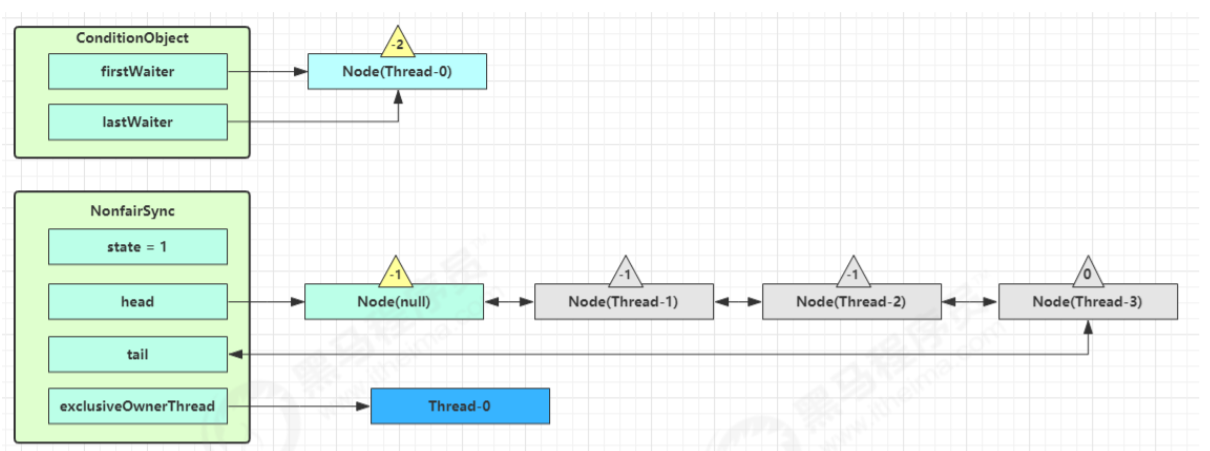
接下来进入 AQS 的 fullyRelease 流程,释放同步器上的锁 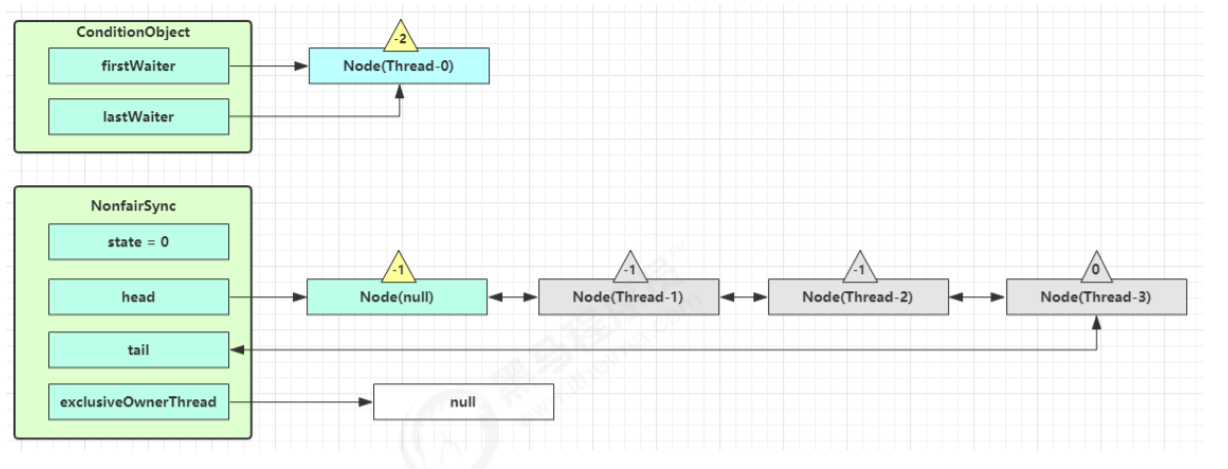
unpark AQS 队列中的下一个节点,竞争锁,假设没有其他竞争线程,那么 Thread-1 竞争成功 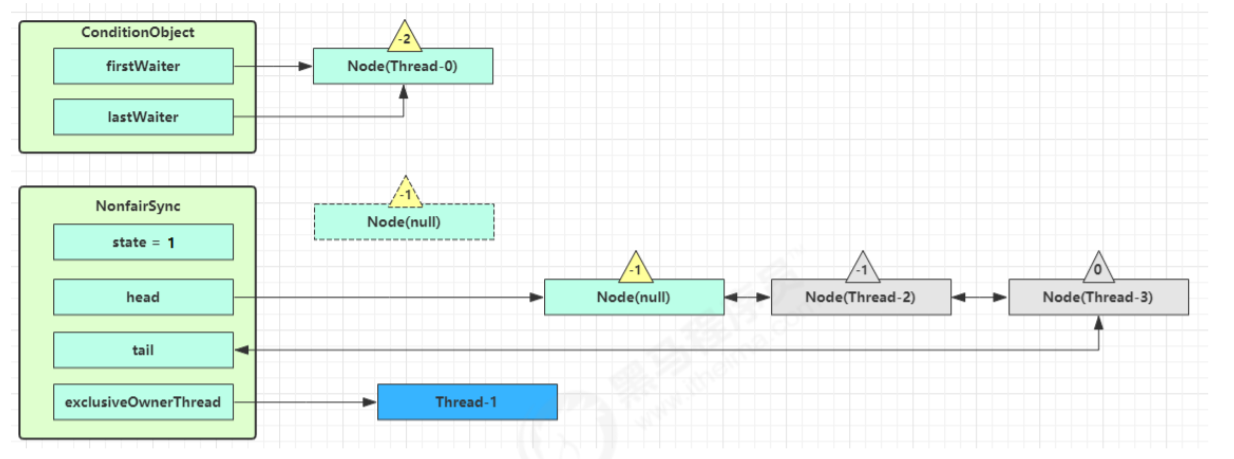
park 阻塞 Thread-0 
signal 流程
假设 Thread-1 要来唤醒 Thread-0 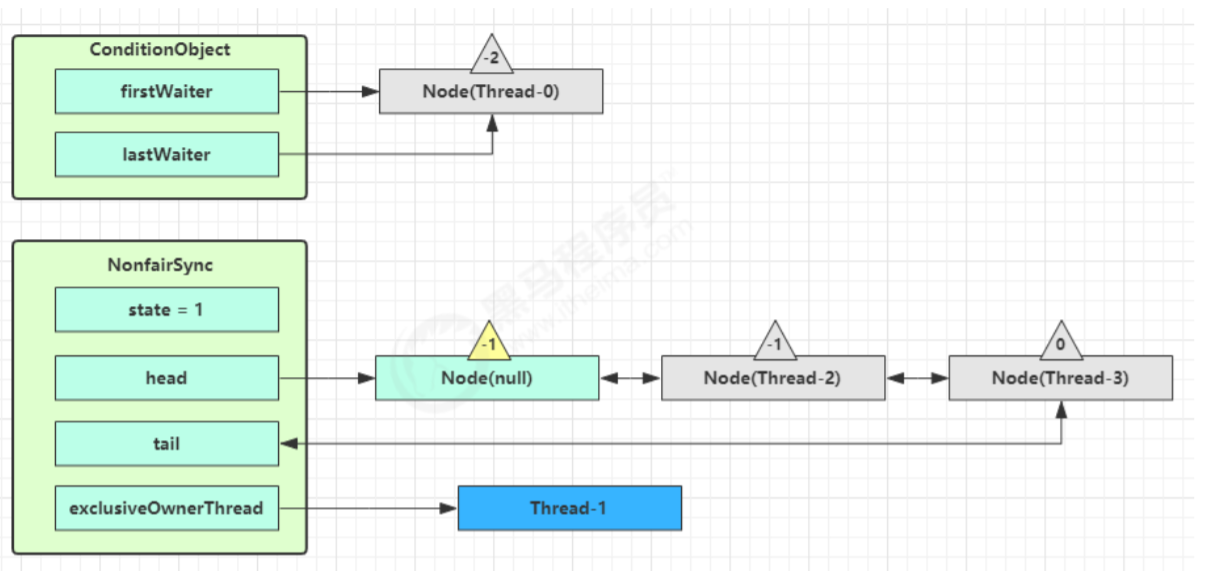
进入 ConditionObject 的 doSignal 流程,取得等待队列中第一个 Node,即 Thread-0 所在 Node 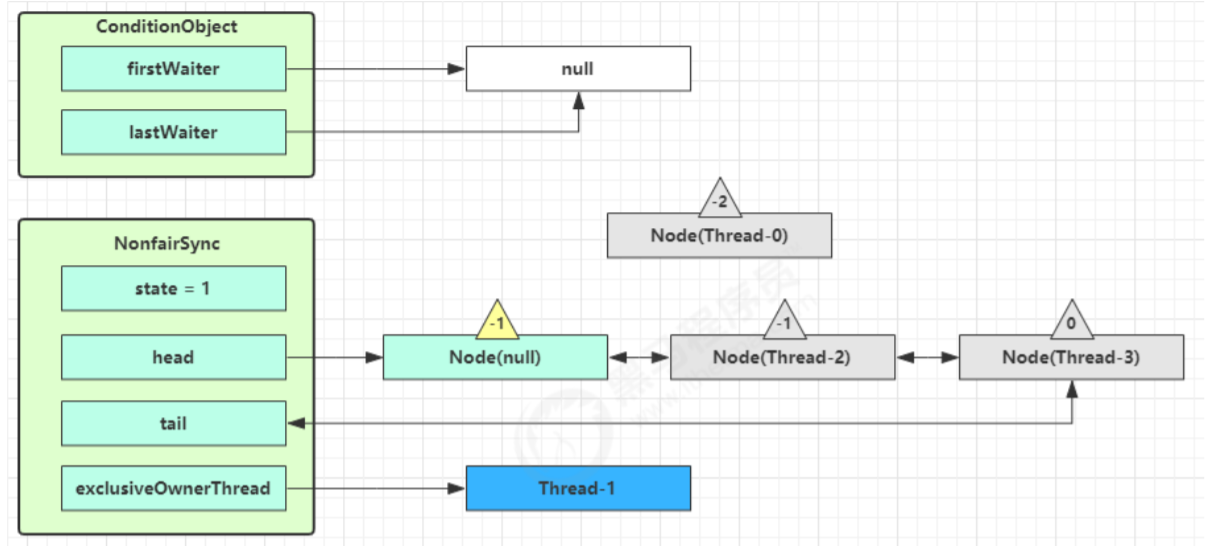
执行 transferForSignal 流程,将该 Node 加入 AQS 队列尾部,将 Thread-0 的 waitStatus 改为 0,Thread-3 的 waitStatus 改为 -1 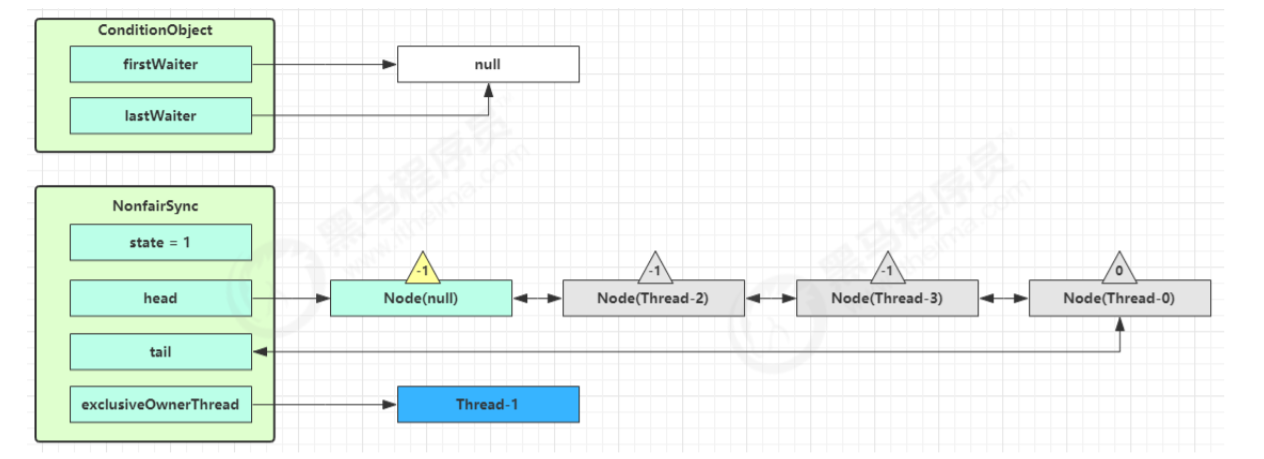
Thread-1 释放锁,进入 unlock 流程,略
源码
public class ConditionObject implements Condition, java.io.Serializable {private static final long serialVersionUID = 1173984872572414699L;// 第一个等待节点private transient Node firstWaiter;// 最后一个等待节点private transient Node lastWaiter;public ConditionObject() { }// ㈠ 添加一个 Node 至等待队列private Node addConditionWaiter() {Node t = lastWaiter;// 所有已取消的 Node 从队列链表删除, 见 ㈡if (t != null && t.waitStatus != Node.CONDITION) {unlinkCancelledWaiters();t = lastWaiter;}// 创建一个关联当前线程的新 Node, 添加至队列尾部Node node = new Node(Thread.currentThread(), Node.CONDITION);if (t == null)firstWaiter = node;elset.nextWaiter = node;lastWaiter = node;return node;}// 唤醒 - 将没取消的第一个节点转移至 AQS 队列private void doSignal(Node first) {do {// 已经是尾节点了if ( (firstWaiter = first.nextWaiter) == null) {lastWaiter = null;}first.nextWaiter = null;} while (// 将等待队列中的 Node 转移至 AQS 队列, 不成功且还有节点则继续循环 ㈢!transferForSignal(first) &&// 队列还有节点(first = firstWaiter) != null);}// 外部类方法, 方便阅读, 放在此处// ㈢ 如果节点状态是取消, 返回 false 表示转移失败, 否则转移成功final boolean transferForSignal(Node node) {// 如果状态已经不是 Node.CONDITION, 说明被取消了if (!compareAndSetWaitStatus(node, Node.CONDITION, 0))return false;// 加入 AQS 队列尾部Node p = enq(node);int ws = p.waitStatus;if (// 上一个节点被取消ws > 0 ||// 上一个节点不能设置状态为 Node.SIGNAL!compareAndSetWaitStatus(p, ws, Node.SIGNAL)) {// unpark 取消阻塞, 让线程重新同步状态LockSupport.unpark(node.thread);}return true;}// 全部唤醒 - 等待队列的所有节点转移至 AQS 队列private void doSignalAll(Node first) {lastWaiter = firstWaiter = null;do {Node next = first.nextWaiter;first.nextWaiter = null;transferForSignal(first);first = next;} while (first != null);}// ㈡private void unlinkCancelledWaiters() {// ...}// 唤醒 - 必须持有锁才能唤醒, 因此 doSignal 内无需考虑加锁public final void signal() {if (!isHeldExclusively())throw new IllegalMonitorStateException();Node first = firstWaiter;if (first != null)doSignal(first);}// 全部唤醒 - 必须持有锁才能唤醒, 因此 doSignalAll 内无需考虑加锁public final void signalAll() {if (!isHeldExclusively())throw new IllegalMonitorStateException();Node first = firstWaiter;if (first != null)doSignalAll(first);}// 不可打断等待 - 直到被唤醒public final void awaitUninterruptibly() {// 添加一个 Node 至等待队列, 见 ㈠Node node = addConditionWaiter();// 释放节点持有的锁, 见 ㈣int savedState = fullyRelease(node);boolean interrupted = false;// 如果该节点还没有转移至 AQS 队列, 阻塞while (!isOnSyncQueue(node)) {// park 阻塞LockSupport.park(this);// 如果被打断, 仅设置打断状态if (Thread.interrupted())interrupted = true;}// 唤醒后, 尝试竞争锁, 如果失败进入 AQS 队列if (acquireQueued(node, savedState) || interrupted)selfInterrupt();}// 外部类方法, 方便阅读, 放在此处// ㈣ 因为某线程可能重入,需要将 state 全部释放final int fullyRelease(Node node) {boolean failed = true;try {int savedState = getState();if (release(savedState)) {failed = false;return savedState;} else {throw new IllegalMonitorStateException();}} finally {if (failed)node.waitStatus = Node.CANCELLED;}}// 打断模式 - 在退出等待时重新设置打断状态private static final int REINTERRUPT = 1;// 打断模式 - 在退出等待时抛出异常private static final int THROW_IE = -1;// 判断打断模式private int checkInterruptWhileWaiting(Node node) {return Thread.interrupted() ?(transferAfterCancelledWait(node) ? THROW_IE : REINTERRUPT) :0;}// ㈤ 应用打断模式private void reportInterruptAfterWait(int interruptMode)throws InterruptedException {if (interruptMode == THROW_IE)throw new InterruptedException();else if (interruptMode == REINTERRUPT)selfInterrupt();}// 等待 - 直到被唤醒或打断public final void await() throws InterruptedException {if (Thread.interrupted()) {throw new InterruptedException();}// 添加一个 Node 至等待队列, 见 ㈠Node node = addConditionWaiter();// 释放节点持有的锁int savedState = fullyRelease(node);int interruptMode = 0;// 如果该节点还没有转移至 AQS 队列, 阻塞while (!isOnSyncQueue(node)) {// park 阻塞LockSupport.park(this);// 如果被打断, 退出等待队列if ((interruptMode = checkInterruptWhileWaiting(node)) != 0)break;}// 退出等待队列后, 还需要获得 AQS 队列的锁if (acquireQueued(node, savedState) && interruptMode != THROW_IE)interruptMode = REINTERRUPT;// 所有已取消的 Node 从队列链表删除, 见 ㈡if (node.nextWaiter != null)unlinkCancelledWaiters();// 应用打断模式, 见 ㈤if (interruptMode != 0)reportInterruptAfterWait(interruptMode);}// 等待 - 直到被唤醒或打断或超时public final long awaitNanos(long nanosTimeout) throws InterruptedException {if (Thread.interrupted()) {throw new InterruptedException();}// 添加一个 Node 至等待队列, 见 ㈠Node node = addConditionWaiter();// 释放节点持有的锁int savedState = fullyRelease(node);// 获得最后期限final long deadline = System.nanoTime() + nanosTimeout;int interruptMode = 0;// 如果该节点还没有转移至 AQS 队列, 阻塞while (!isOnSyncQueue(node)) {// 已超时, 退出等待队列if (nanosTimeout <= 0L) {transferAfterCancelledWait(node);break;}// park 阻塞一定时间, spinForTimeoutThreshold 为 1000 nsif (nanosTimeout >= spinForTimeoutThreshold)LockSupport.parkNanos(this, nanosTimeout);// 如果被打断, 退出等待队列if ((interruptMode = checkInterruptWhileWaiting(node)) != 0)break;nanosTimeout = deadline - System.nanoTime();}// 退出等待队列后, 还需要获得 AQS 队列的锁if (acquireQueued(node, savedState) && interruptMode != THROW_IE)interruptMode = REINTERRUPT;// 所有已取消的 Node 从队列链表删除, 见 ㈡if (node.nextWaiter != null)unlinkCancelledWaiters();// 应用打断模式, 见 ㈤if (interruptMode != 0)reportInterruptAfterWait(interruptMode);return deadline - System.nanoTime();}// 等待 - 直到被唤醒或打断或超时, 逻辑类似于 awaitNanospublic final boolean awaitUntil(Date deadline) throws InterruptedException {// ...}// 等待 - 直到被唤醒或打断或超时, 逻辑类似于 awaitNanospublic final boolean await(long time, TimeUnit unit) throws InterruptedException {// ...}// 工具方法 省略 ...}
